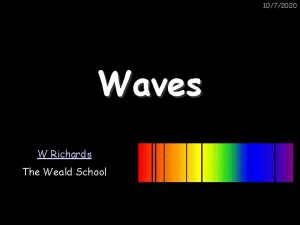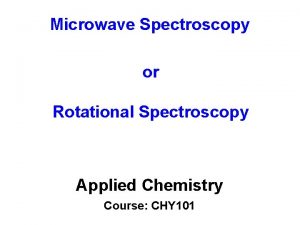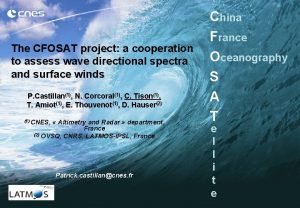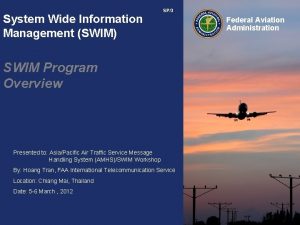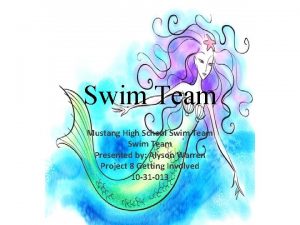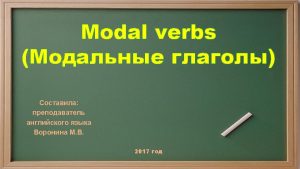Estimation of wave spectra with SWIM on CFOSAT

















- Slides: 17

Estimation of wave spectra with SWIM on CFOSAT – illustration on a real case C. Tison(1), C. Manent(2), T. Amiot(1), V. Enjolras(3), D. Hauser(2), L. Rey(3), P. Castillan(1) CNES, « Altimetry and Radar » department, France (2) UVSQ, CNRS, LATMOS-IPSL, France (3) Thalès Alenia Space, France celine. tison@cnes. fr

Overview of the presentation ■ SWIM instrument and measures ■ Performance budget w Simu. SWIM – an end-to-end simulator w A real sea state condition w Results IGARSS’ 11 – July, 2011 2

The CFOSAT mission China France Oceanography SATellite ■ Status of the program: w Conception and Development phase w Launch planned end of 2014 ■ SWIM w Measurement of the oceanic wave properties w Real-aperture radar with 6 beams (Ku band) ■ SCAT w Measurement of wind sea surface w Real-aperture radar (bi polar, Ku band) ■ Ku. ROS w Airborne sensor developed by LATMOS w Validation of SWIM and SCAT More on the CFOSAT mission tomorrow – session WE 4. T 10 Altimetry I IGARSS’ 11 – July, 2011 3

SWIM instrument (1/2) SWIM: Surface Wave Investigation and Monitoring Ku-band radar (scatterometer) 6 beams IGARSS’ 11 – July, 2011 4

SWIM instrument (2/2) Swell § Nadir signal SWH and wind speed - Accuracy SWH: max(10% of SWH, 50 cm) -Accuracy wind speed: 2 m/s Wind sea § 10°, 8° and 6° beams wave spectrum - spatial sampling of 70 x 70 Km² - Detectable wavelength : λ ~ [70 - 500] m - Azimuth accuracy: 15° - Energy accuracy: 15% § All beams backscattering coefficient profiles: - Absolute accuracy < +/- 1 d. B - Relative accuracy (between beams) < +/- 0. 1 d. B IGARSS’ 11 – July, 2011 5

Estimation of wave spectra Received power Directional wave spectrum F(kx, ky) Wave topography: ξ(x, y) Signal modulation Modulation of the backscattering coefficient Modulation spectrum Pm Wave slopes Link slope/signal modulation IGARSS’ 11 – July, 2011 6

Simulations End-to-end simulation tool: Simu. SWIM ■ Simulations from the sea surface to the estimated signal w Input = sea state conditions w Output = wave spectrum computation of backscattered intensity and processing similar to the future ground segment use SWIM parameters 0° 2° 4° 6° 8° 10° Max integration time (ms) 51. 8 31. 5 22. 5 30. 1 37. 4 Bc (MHz) 320 320 320 PRF (Hz) 2125 fixed 6407 -6739 variable 6378 -6707 variable 6340 -6667 variable Nimp (fixed) 110 60 60 144 192 237 SNR (d. B) 24. 3 11. 9 8. 7 6. 8 4. 8 2. 3 IGARSS’ 11 – July, 2011

Simulations End-to-end simulation tool: Simu. SWIM Surface computation Nimp pulses per cycles Input spectrum (models, measurements) At a given azimuth direction: - Computation of the Nimp backscattered Backscattered signal pulses (knowing SWIM 2 options: geometry and properties) 1. Computation of the Nimp pulses (with geometrical migrations and noises for each) 2. Computation of one pulse and additions of noise (thermal+speckle) to create the Nimp pulses with central migrations - Addition of the Nimp signals IGARSS’ 11 – July, 2011 8

Simulations End-to-end simulation tool: Simu. SWIM Surface computation Input spectrum (models, measurements) Backscattered signal (knowing SWIM geometry and properties) Estimated modulation spectrum Quality criteria IGARSS’ 11 – July, 2011 9

■ Case of November, 2002 storm in Atlantic ocean Lead to the sinking of the Prestige (oil tanker) ■ Very different conditions during the day w 00: low wind sea + dominant swell w 06: 00: very young wind sea (high wind) + dominant swell w 08: 00: mature wind sea + dominant swell w 15: 00: crossed wind seas (old + young) Wind sea rotated by about 120° IGARSS’ 11 – July, 2011 © BSAM/Douanes françaises A real sea state condition: “Prestige case” Spain Galician coast

A real sea state condition: “Prestige case” IGARSS’ 11 – July, 2011

A real sea state condition: “Prestige case” ■ Available data w MFWAM output with ALADIN winds (Météo France models of wind and waves) 2 D polar azimuth/frequency height spectrum converted into 2 D cartesian wavenumber by bilinear interpolation w Subset of results: 00, 06, 08, 10, 15 UTC (different wind and waves cases) ■ Simulation conditions w Incidence angle: 10° w Nimp = 237 pulses per cycle ( averaging for noise reduction) w Rotation speed = 5. 7 rpm ( 49 cycles / 360°) IGARSS’ 11 – July, 2011

Simulation results Reference: 2 D spectrum from WAM model èSame detection of swell and wind sea partitions èSmall underestimation IGARSS’ 11 – July, 2011 06: 00 UTC CFOSAT/SWIM estimation (simulations from Simu. SWIM)

1 D modulation spectra 6 h UTC Swell Φ=135° (SE-NW look direction) Sea wind Φ = 235° (NE-SW look direction) Φ = angle between satellite track (assumed S-N) and radar look direction IGARSS’ 11 – July, 2011

00: 00 UTC 06: 00 UTC 08: 00 UTC 10: 00 UTC 15: 00 UTC Prestige SOS 14: 00 UTC Reference: 2 D spectrum from WAM model CFOSAT/SWIM estimation (simulations from Simu. SWIM) Hs: 5. 1 m U: 11. 7 m/s IGARSS’ 11 – July, 2011 Hs: 5. 8 m U: 22. 2 m/s Hs: 6. 1 m U: 8. 8 m/s Hs: 6. 5 m U: 21. 0 m/s Hs: 6. 5 m U: 17. 3 m/s

Performance quality Estimation errors on wave direction (Φ), wavelength (λ) and energy (E): SWELL WIND SEA Φ λ E 00 h 3° 0% 4% - - - 06 h 0° 0% 13% 11° 27% 19% 08 h 0° 1% 7% 11° 18% 6% 10 h 0° 8% 8% 11° 6% 7% 15 h 3° 12% 6% 7° 19% 5% <15° <10 -20% <15% Requirements: IGARSS’ 11 – July, 2011

Conclusions ■ Simulations of SWIM wave products w End-to-end simulations w Software with realistic sensor conditions w Accurate results with a large variety of sea state conditions ■ Next steps w Keep-on the definition of the inversion algorithms w Optimize inversion up to wave spectrum estimation of the transfer function (α) IGARSS’ 11 – July, 2011
 Fox valley wave swim team
Fox valley wave swim team Velocity frequency wavelength triangle
Velocity frequency wavelength triangle Earthquake p wave and swave travel time
Earthquake p wave and swave travel time Half-wave symmetry
Half-wave symmetry Transverse and longitudnal waves
Transverse and longitudnal waves Rectified sine wave fourier series
Rectified sine wave fourier series Sound waves are mechanical waves true or false
Sound waves are mechanical waves true or false Venn diagram of mechanical and electromagnetic waves
Venn diagram of mechanical and electromagnetic waves Define half wave rectifier
Define half wave rectifier What is a wave
What is a wave Short wave vs long wave radiation
Short wave vs long wave radiation Mechanical waves characteristics
Mechanical waves characteristics Full wave rectifier vs half wave rectifier
Full wave rectifier vs half wave rectifier The wave chapter 10
The wave chapter 10 Difference between full wave and half wave rectifier
Difference between full wave and half wave rectifier Iron carbonyl fe co 5 is
Iron carbonyl fe co 5 is Star spectra
Star spectra Microwave spectroscopy
Microwave spectroscopy
















